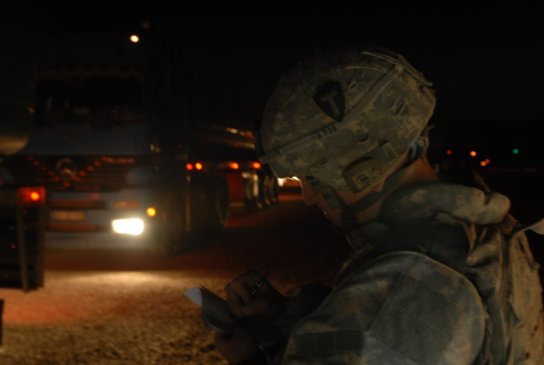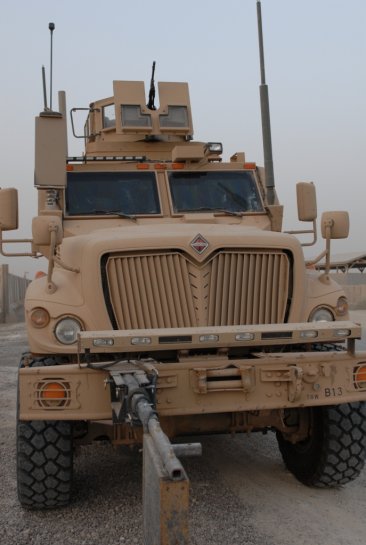« Judge: Eligibility dispute is 'serious' | Main | Governor Palin Visits Camp Bondsteel ( More Videos) »
June 29, 2009
Texas National Guard Known As The "High Plains Infantry"

Staff Sgt. Richard Shaver, acting platoon sergeant for 1st Platoon, B Company, 2nd Battalion 142nd Infantry, 56th Infantry Brigade Combat Team, counts trucks coming out of the convoy yard at Camp Korean Village on the night of June 23. Shaver, of Arlington, Texas, counts all the trucks out of the gate checking his manifest to ensure accountability.

Spc. Timothy Stewart, a vehicle driver serving with B Company, 2nd Battalion 142nd Infantry, 56th Infantry Brigade Combat Team, checks transmission fluid levels in his Mine Resistant Ambush Protected vehicle in the early morning hours, June 23, following a seven hour long convoy.

A Mine Resistant Ambush Protected Vehicle in 2nd Battalion 142nd Infantry Division, 56th Infantry Brigade Combat Team, stands ready for a convoy mission from Camp Victory in Baghdad past the city of Ar Rutbah in far western Iraq, June 22.
BAGHDAD
For the second time in four years, troops from a Texas National Guard unit finds themselves in the full time service to their state and nation supporting Operation Iraqi Freedom.
For some Soldiers of 2nd Battalion, 142nd Infantry Regiment, 56th Infantry Brigade Combat Team, deployment to the Middle East bares a close resemblance to home station.
Known as the "High Plains Infantry", the companies that comprise the battalion are primarily found in the high plains area of the panhandle of northwestern Texas. This part of Texas has terrain that is mostly flat with moderate elevation and has high winds and temperatures during the summer; no different than many parts of Iraq.
This time around, they secure and escort convoys of critical supplies, everything from beans and bullets to water and fuel across western Iraq in the famed al-Anbar province.
"Every single widget we use, from a slice of bread at chow to the fuel that runs our generators is brought in by ground convoy, and Texan Soldiers are the ones protecting it," said Lt. Col. Christopher Link, 56th IBCT operations officer of Mansfield, Texas.
These convoy missions can take several days to complete and when rolling on the road, can stretch for several miles from the lead vehicle to the truck pulling up the rear.
"This mission normally puts about 1,000 miles on each of our trucks," explained acting platoon sergeant, Staff Sgt. Richard Shaver, of Arlington, Texas.
For Shaver, most missions normally lasts about four or five days, depending on execution times and cooperating weather. That's five days of living out of a backpack, sleeping irregular hours, operating under the starry nights of western Iraq and sleeping in makeshift huts under the blaring desert sun.
Rolling out of the sprawling Victory Base Complex on the western edge of Baghdad, Soldiers escort more than 30 tractor trailer trucks and start heading west in Mine Resistant Ambush Protected Vehicles. The large trucks can strike an intimidating presence.
"I like driving the MRAP because civilians [in smaller vehicles] tend to stay clear when they see a 25,000 pound truck coming," said a wide smiling Spc. Timothy Stewart, a vehicle driver from Rock Port, Texas.
The convoy traveled more than 250 miles during the night, often times barely crawling along due to sub-standard road conditions.
Along the way, vehicle breakdowns increase the timeline and prompts Shaver to say, "We might see daylight before we finish tonight boys." Once everyone has pulled into their destination, all the vehicles top off with fuel and get ready to go again the next day. As they look to the east, troops see the beginnings of daybreak and head to the dining facility for a breakfast meal that for many of the Soldiers will serve as supper.
The mood is light as everyone enjoys a helping of eggs, bacon and fruit. Some enjoy cereal and some of the many other choices available at the dining facility. Following chow, many of the Soldiers retire for the morning into a plywood building for a few hours of shut-eye.
As the afternoon sun begins to bake the desert at a stifling 110 degrees, many of the Soldiers begin to stir. Within a couple of hours these Soldiers start all the preparations of once again heading out on the road. As they ready their trucks, checking fluid levels and doing communications checks, the word comes that the convoy may not push out.
"I don't mind spending an extra day out, because when we are out on the road it makes the days go by quicker," said Sgt. Ryan Northcutt, a squad leader from Longview, Texas.
Many of the various missions performed throughout Iraq require a degree of flexibility and the capacity to change direction at the drop of a hat. On this night, the Soldiers would be put on standby because of unfavorable route status, only to be given the word "Go" after many had relaxed and settled in for what was thought to be an extra night on the camp.
"You absolutely have to be flexible in this mission, said Shaver. "We can go from being stood down and not moving to hitting an [start point] within an hour."
Like the rest of the convoy, the security platoons operate using three elements: a forward security element for added safety and a sense of warn for the Soldiers on the mission, a main body who escorts the bulk of the semi-trucks with the supplies, and a recovery element which acts to recover any of the vehicles that may experience problems ranging from transmission problems to something as innocuous as a simple flat tire.
"We operate with three elements within the convoy. Each element operates semi-independently of each other. Their tasks being completed can make or break a mission," Shaver explained.
Along the route the recovery team got a chance to exercise their skills as a fuel tanker had a tire blowout. The blowout caused the loss of two tires and both had to be replaced before the mission could continue.
On this night however, this would not be the only maintenance issue that these Soldiers would be faced with. A separate trailer had tire issues as well, including the loss of some of the highly important lug nuts used to keep the wheels on and rolling down the supply routes. After some controlled substitution amongst the contracted drivers of the fuel tankers, the mission, once again continued towards the Iraqi capital. There would be, however, one more breakdown.
This final breakdown happened along the supply route to Baghdad near Fallujah, some 30 miles west of the capital city. This incident would test the resolve and patience of the recovery crew.
Unable to self recover, Shaver's Soldiers would wait nearly 10 hours on the outskirts of Fallujah in searing heat all the while maintaining 360 degree security protecting the vital fuel in the tanker, and wait for addition recovery assets.
"Whenever we can't self recover, we wait for additional assets to get to us. Sometimes that wait is only a couple of hours and sometimes it is longer," said Shaver.
Glad to be moving again, the recovery element of 1st Platoon breathe a sigh of relief as they finally continue towards Victory Base Complex on the western edge of Baghdad for some well deserved rest after their 22 hours on the road. Even on what many consider the most inhospitable terrain in Iraq and through scorching temperatures, the High Plains Infantrymen complete their tasks with a unique pride that lets them feel at home.

Wild Thing's comment......
God bless each one of them and protect them and keep them safe.
Posted by Wild Thing at June 29, 2009 05:47 AM
Comments
36th Texas National Guard division, known as the "T Patchers" for their arrowhead shoulder patch with the big T in it.
Posted by: TomR at June 29, 2009 12:39 PM
High Plains Infantry, That is a great Name.
Posted by: Mark at June 29, 2009 07:57 PM
Tom, thank you so much.
Posted by: Wild Thing at June 30, 2009 12:52 AM
Mark, I thought so too. I love
when they give these names like this.
Posted by: Wild Thing at June 30, 2009 12:53 AM
